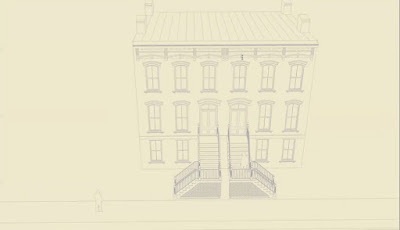It's not often that the Historic Preservation Commission talks about paint and paint color. The last time was in September 2022, when the plans for painting 529 Warren Street were brought to the commission's attention.
At that time, Victoria Polidoro, legal counsel to the HPC, recommended that the HPC form a working group to come up with a proposal regarding the use of paint in historic districts. That never happened, but it may be an idea whose time has come. At last Friday's meeting of the HPC, Phil Forman, who chairs the commission, has quite intense in his disapproval of the use of paint in the restoration of a pair of houses on lower Allen Street. The restoration is being done by Galvan.
At a previous meeting of the HPC, Walter Chatham proposed metal staircases for the buildings which the HPC thought had too much of a "fire escape" look. At Friday's meeting, Chatham returned with a proposal that the HPC found more acceptable.
The HPC hailed the new proposal as "a great turnaround in design" and granted a certificate of appropriateness. What was not part of the proposal and what Forman wanted to talk about was paint. The paint has been removed from the brick, and everything else--the cornice, the window sills and lintels, even the marble string course--has been painted black.
Forman argued that the black paint "disappears" all the historic details on the building. The purpose of historic preservation, Forman maintained, was to prevent destroying or irradicating critical historic detail. "The spirit of the thing is not to destroy, mask, minimize, erase historic detail," said Forman, and detail on this building has now been "masked, covered, and deleted" with black paint.
Chatham said it was his understanding that "if something has been painted it can be painted again without review." He maintained that everything that was painted black had been painted previously.
Craig Haigh, code enforcement officer, noted that the original building permit was for interior work only, implying that all work on the exterior had been done without an appropriate permit, but he supported Chatham's understanding, saying, "Once a [masonry] building has been painted, it can be repainted without review." He asserted there had been "no wrongdoing, based on the code as it existed." He went on to say the code, as it pertains to historic preservation, was adopted seventeen years ago and suggested that it may need to be updated.
Summing up the discussion, Polidoro asked a question that went unanswered: "Do you want to propose a code amendment to regulate paint?"
It was then that Paul Barrett, the historian member of the HPC, shared this picture of the building, probably taken in the late 1930s or early 1940s.
Whether or not the HPC will take up the matter of amending the code to address paint, it is useful to remember that paint is not forever. Chatham defended the action at 28-30 Allen Street by pointing out that before the "rotting white cornice" was painted black, it had been repaired, asserting. "It's not as if something has been lost." It's also useful to remember that once upon a time 116 Warren Street, our rare example of Adam style architecture, was completely painted, marble pilasters and medallions and all, in a single color. (I've been told it was red.)









In my opinion it would be wise for HPC to tread lightly around the issue of regulating paint color. The control over what color someone can paint their own property has been a long-time cliche around overzealous preservationists and sounds like something that would come from a suburban HOA. With the exception of something like covering over natural brick or stone, the choice of color has more to do with personal taste and little to do with preserving historic details. Sometimes you like a paint job, sometimes you don't. If the HPC actively pursues change of code around color choice it will bring annoyance and ridicule from the majority of the public. It will also provide ammunition to those that would seek to scale back historic preservation law in the name of affordability, density and new urbanism. HPC should not fly too close to the sun and just enjoy their fiefdom where they get to nitpick things like the plans of frustrated homeowners who want to replace their windows in order to lower their power bill but can't afford 12 over 12 pane windows.
ReplyDeleteBlack everywhere is a cop out.
ReplyDelete